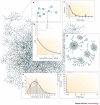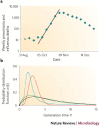Mathematical models of infectious disease transmission
- PMID: 18533288
- PMCID: PMC7097581
- DOI: 10.1038/nrmicro1845
Mathematical models of infectious disease transmission
Abstract
Mathematical analysis and modelling is central to infectious disease epidemiology. Here, we provide an intuitive introduction to the process of disease transmission, how this stochastic process can be represented mathematically and how this mathematical representation can be used to analyse the emergent dynamics of observed epidemics. Progress in mathematical analysis and modelling is of fundamental importance to our growing understanding of pathogen evolution and ecology. The fit of mathematical models to surveillance data has informed both scientific research and health policy. This Review is illustrated throughout by such applications and ends with suggestions of open challenges in mathematical epidemiology.
Figures




References
-
- Heesterbeek H. Ecological Paradigms Lost: Routes of Theory Change. 2005. pp. 81–105.
-
- Anderson RM, May RM. Infectious diseases of humans: dynamics and control. 1991.
Publication types
MeSH terms
LinkOut - more resources
Full Text Sources
Medical

